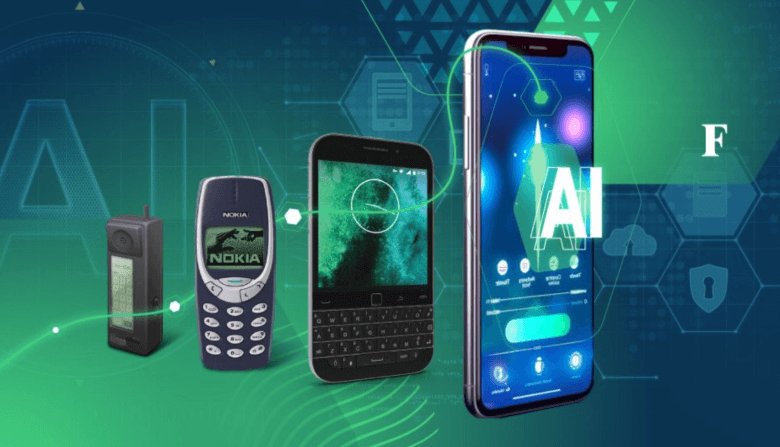The Evolution of Smartphones: From Basic Phones to Smart Devices

Introduction: The Rise of Smartphones
The evolution of smartphones is a fascinating journey that has reshaped the way we live, work, and interact with the world around us. From the simple, functional designs of basic phones to the advanced, feature-packed smart devices of today, smartphones have come a long way. In this article, we will explore this journey in detail, tracing the development of these iconic devices and how they have transformed from basic communication tools to multifunctional devices.
The Early Days: The Birth of Basic Phones
In the 1980s, mobile phones were heavy, expensive, and primarily used for voice communication. These “basic phones” were large, bulky devices with limited functionality. The primary focus of these early devices was to provide a means of communication while on the go. The most famous early mobile phone was the Motorola DynaTAC 8000X, released in 1983. This device weighed nearly 2.5 pounds and cost around $4,000, a far cry from today’s lightweight and affordable smartphones.
Key Features of Basic Phones:
- Voice calls: The primary function of basic phones was voice communication.
- Limited battery life: Basic phones had a battery life of several hours, and many had to be recharged frequently.
- No screens: Early mobile phones had either no screen or just a simple LED display for basic information like signal strength.
The rise of these early phones marked the beginning of the mobile revolution, but they were far from the multifunctional smart devices we use today.
See also: The Role of Virtual Reality in Education and Training
The 1990s: The Emergence of Texting and the First Smartphones
The 1990s brought the first significant shift in mobile phone functionality with the advent of SMS (Short Message Service), which allowed users to send text messages. This era also saw the launch of the first true “smartphones,” which combined basic phone functionality with additional features such as email and limited internet browsing.
One of the key milestones in this evolution was the release of the IBM Simon Personal Communicator in 1994. This device was one of the first to include a touchscreen interface, email capabilities, and basic apps like a calendar and a notepad. It could also make phone calls and send faxes, which was revolutionary at the time.
Notable Innovations in the 1990s:
- SMS/Texting: The ability to send and receive text messages became a game changer.
- Touchscreen: IBM’s Simon was one of the first mobile devices to use a touchscreen.
- Multimedia Messaging: While primitive by today’s standards, this era laid the foundation for the future of multimedia messaging services (MMS).
The 1990s marked the beginning of the transition from simple mobile phones to devices that could do more than just place calls.
The 2000s: The Era of Mobile Internet and Feature Phones
As we entered the 2000s, mobile phones began to evolve rapidly, driven by technological advancements. Mobile internet became more accessible, and features such as cameras, Bluetooth, and better displays became common.
One of the most significant milestones of this period was the introduction of the Nokia 3310 in 2000. This phone became iconic due to its durability, long battery life, and simplicity. However, the 2000s were also marked by the release of phones with more advanced features, such as the BlackBerry series, which provided users with internet access and email on the go.
Key Features of 2000s Mobile Phones:
- Cameras: Early mobile phones started to include basic cameras.
- Mobile Internet: While not as fast as modern connections, 2G and 3G technology allowed for basic web browsing.
- Bluetooth: This wireless technology allowed for easier file transfers and hands-free communication.
In this era, mobile phones became much more versatile, but they still didn’t yet offer the full smartphone experience that would come a few years later.
The Late 2000s and Early 2010s: The iPhone Revolution and the Rise of Modern Smartphones
The game-changing moment in the evolution of smartphones occurred in 2007 when Apple introduced the iPhone. With its sleek design, full touchscreen, and intuitive interface, the iPhone revolutionized the mobile phone industry. It was the first true “smartphone” as we know it today.
Apple’s iPhone, followed by the introduction of Google’s Android operating system, reshaped the mobile landscape. These devices brought full-fledged web browsing, an ecosystem of apps, and powerful hardware into the hands of users. The App Store and Android Market (now Google Play) provided a marketplace for thousands of apps, ranging from entertainment and productivity to games and social networking.
Key Features of the First Modern Smartphones:
- Touchscreen: Full-touch screen interfaces became the standard.
- App Stores: Both Apple and Android developed app marketplaces that allowed users to customize their phones.
- Advanced Operating Systems: iOS and Android provided full operating systems capable of supporting various apps and functionalities.
- Internet Access: With the introduction of 3G and later 4G networks, mobile internet browsing became fast and efficient.
The late 2000s and early 2010s saw the rise of smartphones that could perform tasks beyond just calling and texting, such as browsing the internet, playing music, and running complex apps.
The 2010s: Advanced Features and the Mobile App Revolution
By the 2010s, smartphones had become an integral part of daily life. Devices like the iPhone 5 and Samsung Galaxy S series introduced new technologies like improved cameras, faster processors, and larger screens. This era also marked the rapid development of mobile apps, turning smartphones into versatile tools for everything from navigation and shopping to fitness tracking and remote work.
Smartphones also began to include more advanced features such as facial recognition, biometric security, and augmented reality (AR). The rise of cloud computing and 4G networks made smartphones even more powerful, allowing for faster data access and improved performance.
Innovations in the 2010s:
- High-Resolution Cameras: Smartphones became popular for photography, with advancements like optical zoom and portrait mode.
- 5G Networks: The rollout of 5G began, offering faster data speeds and lower latency for mobile users.
- AI Integration: Virtual assistants like Siri, Google Assistant, and Alexa became commonplace on smartphones.
- Augmented Reality: Smartphones started integrating AR for games, apps, and navigation.
The 2010s were a transformative period where smartphones were no longer just communication devices but powerful tools that integrated into every aspect of our daily lives.
2020s: The Future of Smartphones – Foldable Phones, AI, and Beyond
As we entered the 2020s, smartphones continued to evolve, with new technologies like foldable screens and advanced artificial intelligence (AI) becoming central to the latest innovations. Companies like Samsung and Huawei introduced foldable devices that offered larger displays in a compact form, further enhancing the versatility of smartphones.
Additionally, 5G networks became widespread, offering faster speeds and improved connectivity. Smartphones began to integrate AI-powered features like personalized recommendations, improved camera technology, and even autonomous tasks such as system optimization and security features.
Key Features of 2020s Smartphones:
- Foldable Screens: Devices that can fold into a smaller size without compromising on screen real estate.
- Advanced AI: Smartphones are equipped with more sophisticated AI capabilities for personalization, security, and efficiency.
- 5G Connectivity: Ultra-fast data speeds enabling seamless streaming, gaming, and browsing experiences.
- Enhanced Cameras: Advanced camera systems capable of professional-quality photos and videos.
As we look to the future, smartphones are expected to continue evolving with the integration of virtual reality (VR), augmented reality (AR), and more intelligent features powered by machine learning.
The Impact of Smartphones on Society
The evolution of smartphones has had a profound impact on society. These devices have transformed how we communicate, socialize, work, and entertain ourselves. From the way we use social media to the rise of mobile banking, shopping, and remote work, smartphones have reshaped every aspect of modern life.
Smartphones have also played a key role in global connectivity. With apps for language translation, travel, and even health care, smartphones have made the world more accessible. However, this technological revolution has not been without its challenges, including concerns about privacy, addiction, and the digital divide.
FAQs
Q1: What was the first smartphone ever made?
A1: The first smartphone was the IBM Simon Personal Communicator, released in 1994. It featured a touchscreen, email capabilities, and basic apps like a calendar and address book.
Q2: When did smartphones become mainstream?
A2: Smartphones became mainstream after the release of the Apple iPhone in 2007, which revolutionized mobile devices by combining a touchscreen interface with advanced features like the App Store.
Q3: How have smartphones evolved over time?
A3: Smartphones have evolved from basic mobile phones used for voice communication to powerful devices with advanced operating systems, cameras, app ecosystems, and AI-powered features.
Q4: What is the future of smartphones?
A4: The future of smartphones includes the integration of advanced technologies like foldable screens, AI, 5G, and AR/VR. We may also see more emphasis on sustainability and battery life improvement.
Q5: How have smartphones affected communication?
A5: Smartphones have revolutionized communication, allowing instant messaging, video calls, social media interaction, and real-time collaboration on a global scale.
Q6: What are the main challenges associated with smartphone use?
A6: Some challenges include concerns about privacy, screen addiction, digital divide, and the environmental impact of smartphone production and disposal.
Conclusion
The evolution of smartphones from basic phones to the sophisticated smart devices we use today is nothing short of remarkable. What began as a simple tool for communication has transformed into an essential part of our daily lives, influencing everything from how we work to how we interact with the world. As technology continues to advance, smartphones will undoubtedly evolve further, offering new possibilities that we can only begin to imagine.




